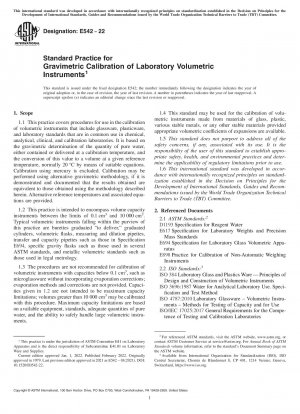ASTM E542-22
Standard Practice for Gravimetric Calibration of Laboratory Volumetric Instruments
- Standard No.
- ASTM E542-22
- Release Date
- 2022
- Published By
- American Society for Testing and Materials (ASTM)
- Latest
- ASTM E542-22
- Scope
- 1.1 This practice covers procedures for use in the calibration of volumetric instruments that include glassware, plasticware, and laboratory standards that are in common use in chemical, analytical, clinical, and calibration laboratories. It is based on the gravimetric determination of the quantity of pure water, either contained or delivered at a calibration temperature, and the conversion of this value to a volume at a given reference temperature, normally 20 °C by means of suitable equations. Calibration using mercury is excluded. Calibration may be performed using alternative gravimetric methodology, if it is demonstrated and documented that the results obtained are equivalent to those obtained using the methodology described herein. Alternative reference temperatures and associated equations are provided. 1.2 This practice is intended to encompass volume capacity instruments between the limits of 0.1 cm3 and 10 000 cm3 . Typical volumetric instruments falling within the purview of this practice are burettes graduated “to deliver,” graduated cylinders, volumetric flasks, measuring and dilution pipettes, transfer and capacity pipettes such as those in Specification E694, specific gravity flasks such as those used in several ASTM standards, and metallic volumetric standards such as those used in legal metrology. 1.3 The procedures are not recommended for calibration of volumetric instruments with capacities below 0.1 cm3 , such as microglassware without incorporating evaporation corrections; evaporation methods and corrections are not provided. Capacities given in 1.2 are not intended to be maximum capacity limitations; volumes greater than 10 000 cm3 may be calibrated with this procedure. Maximum capacity limitations are based on available equipment, standards, adequate quantities of pure water, and the ability to safely handle large volumetric instruments. 1.4 This standard may be used for the calibration of volumetric instruments made from materials of glass, plastic, various stable metals, or any other stable materials provided appropriate volumetric coefficients of expansions are available. 1.5 This standard does not purport to address all of the safety concerns, if any, associated with its use. It is the responsibility of the user of this standard to establish appropriate safety, health, and environmental practices and determine the applicability of regulatory limitations prior to use. 1.6 This international standard was developed in accordance with internationally recognized principles on standardization established in the Decision on Principles for the Development of International Standards, Guides and Recommendations issued by the World Trade Organization Technical Barriers to Trade (TBT) Committee.
ASTM E542-22 Referenced Document
- ASTM D1193 Standard Specification for Reagent Water
- ASTM E617 Standard Specification for Laboratory Weights And Precision Mass Standards
- ASTM E694 Standard Specification for Laboratory Glass Volumetric Apparatus
- ASTM E898 Standard Test Method of Testing Top-Loading, Direct-Reading Laboratory Scales and Balances
- ISO 384 Laboratory glass and plastics ware - Principles of design and construction of volumetric instruments
ASTM E542-22 history
- 2022 ASTM E542-22 Standard Practice for Gravimetric Calibration of Laboratory Volumetric Instruments
- 2021 ASTM E542-01(2021) Standard Practice for Calibration of Laboratory Volumetric Apparatus
- 2001 ASTM E542-01(2012) Standard Practice for Calibration of Laboratory Volumetric Apparatus
- 2001 ASTM E542-01(2007) Standard Practice for Calibration of Laboratory Volumetric Apparatus
- 2001 ASTM E542-01 Standard Practice for Calibration of Laboratory Volumetric Apparatus
- 2000 ASTM E542-00 Standard Practice for Calibration of Laboratory Volumetric Apparatus
